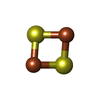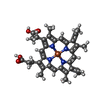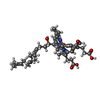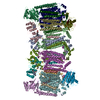+Search query
-Structure paper
| Title | Cryo-Electron Microscopy Structure of the s Cytochrome : Supercomplex and a Novel Inhibitor Targeting Subunit Cytochrome I. |
|---|---|
| Journal, issue, pages | Antimicrob Agents Chemother, Vol. 67, Issue 6, Page e0153122, Year 2023 |
| Publish date | Jun 15, 2023 |
 Authors Authors | Vikneswaran Mathiyazakan / Chui-Fann Wong / Amaravadhi Harikishore / Kevin Pethe / Gerhard Grüber /  |
| PubMed Abstract | The mycobacterial cytochrome complex deserves the name "supercomplex" since it combines three cytochrome oxidases-cytochrome , cytochrome , and cytochrome -into one supramolecular machine and ...The mycobacterial cytochrome complex deserves the name "supercomplex" since it combines three cytochrome oxidases-cytochrome , cytochrome , and cytochrome -into one supramolecular machine and performs electron transfer for the reduction of oxygen to water and proton transport to generate the proton motive force for ATP synthesis. Thus, the complex represents a valid drug target for Mycobacterium tuberculosis infections. The production and purification of an entire M. tuberculosis cytochrome are fundamental for biochemical and structural characterization of this supercomplex, paving the way for new inhibitor targets and molecules. Here, we produced and purified the entire and active M. tuberculosis cyt- oxidase, as demonstrated by the different heme spectra and an oxygen consumption assay. The resolved M. tuberculosis cyt- cryo-electron microscopy structure reveals a dimer with its functional domains involved in electron, proton, oxygen transfer, and oxygen reduction. The structure shows the two cytochrome III head domains of the dimer, the counterpart of the soluble mitochondrial cytochrome , in a so-called "closed state," in which electrons are translocated from the to the domain. The structural and mechanistic insights provided the basis for a virtual screening campaign that identified a potent M. tuberculosis cyt- inhibitor, cyt1. cyt1 targets the mycobacterium-specific α3-helix of cytochrome I and interferes with oxygen consumption by interrupting electron translocation via the III head. The successful identification of a new cyt- inhibitor demonstrates the potential of a structure-mechanism-based approach for novel compound development. |
 External links External links |  Antimicrob Agents Chemother / Antimicrob Agents Chemother /  PubMed:37158740 / PubMed:37158740 /  PubMed Central PubMed Central |
| Methods | EM (tomography) |
| Structure data | EMDB-34664, PDB-8hcr: |
| Chemicals |  ChemComp-FES:  ChemComp-HEM:  ChemComp-HEC:  ChemComp-HEA: |
| Source |
|
 Keywords Keywords | OXIDOREDUCTASE / Cytochrome bcc:aa3 oxidase / Mycobacterium tuberculosis |
 Movie
Movie Controller
Controller Structure viewers
Structure viewers About Yorodumi Papers
About Yorodumi Papers





 mycobacterium tuberculosis variant bovis bcg (bacteria)
mycobacterium tuberculosis variant bovis bcg (bacteria)